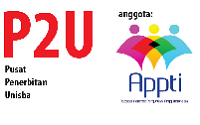Introduction of Rats Pest Control Using Trap Barrier System (TBS) in Farmer Group
Abstract
Abstract. Rats are the main agricultural pests and one of the factors causing crop failure for farmers, especially in Pademawu. Farmers generally use pest control methods using poisons that can pollute the agricultural environment. The application of the Trap Barrier System (TBS) is needed to overcome the rat pestproblem. The service aims to increase partners' insight into implementing rat pest control using TBS. Community service activities in the form of outreach and training. The method used is descriptive quantitative, namely data collection through filling out questionnaires including knowledge skills, level of interest, posttest and pretest for partner knowledge evaluation. The results of the participant's assessment of the benefits of the training through Evaluation of farmers' understanding of the application of TBS technology showed results of 82%. The assessment shows the skills and insights obtained by the farmers are in the good category after carrying out the activities. The participants also showed interest in participating in the activities shown by the participants actively asking and listening during the discussion. TBS has been proven to be able to reduce the level of rat attack on rice by up to 80% so that farmers are interested in using the TBS trap system. Even so, the TBS system cannot break the life cycle of rats and further guidance is needed regarding sustainable cropping and cultivation patterns to overcome this in the farmers' environment in East Pademawu Village.
Keywords
Full Text:
PDFReferences
Arifandi, R. J., Junus, M., & Kusumawardani, M. (2021). Sistem Pengusir Hama Burung dan Hama Tikus Pada Tanaman Padi Berbasis Raspberry pi. Jurnal Jaringan Telekomunikasi, 11(2), 92-95.
BPPP, (2015). Badan Penelitian dan Pengembangan Pertanian. Laboratorium Tikus - Balai Besar Penelitian Tanaman Padi
Baldwin, R., Meinerz, R., & Shiels, A. (2022). Efficacy of Goodnature A24 self-resetting traps and diphacinone bait for controlling black rats (Rattus rattus) in citrus orchards. Management of Biological Invasions, 13(3), 577-592.
Harahap, M. M., Supriana, T., Kabeakan, N. T. M. B., & Yustriawan, D. (2022). Persepsi Petani Terhadap Pola Tanam Dengan Sistem Rotasi Tanam (Padi-Kacang Hijau-Padi) di Desa Paya Rengas Kabupaten Langkat. JASc (Journal of Agribusiness Sciences), 5(2), 140-147.
Imadoeddin, I., Syaiful, S., Aristin, R., Anam, S., & Oktasari, A. F. (2022). Pemberdayaan Masyarakat Pesisir Melalui Pengembangan Sumber Daya Laut (SDL) Dalam Meningkatkan Perekonomian masyarakat Desa Branta Pesisir Kecamatan Tlanakan Kabupaten Pamekasan. COVIT (Community Service of Health), 2(2), 247-257.
Sekarweni, H. W., Pujiastuti, Y., & Herlinda, S. (2019). Application of trap barrier system combined with cage trap for controlling rats in rice field. BIOVALENTIA: Biological Research Journal, 5(1), 1-7.
Siregar, H. M., Priyambodo, S., & Hindayana, D. (2020). Preferensi Serangan Tikus Sawah (Rattus argentiventer) Terhadap Tanaman Padi. Agrovigor: Jurnal Agroekoteknologi, 13(1), 16-21.
Siregar, H. M., Priyambodo, S., & Hindayana, D. (2021). Analisis pergerakan tikus sawah (Rattus argentiventer) menggunakan linear trap barrier system. Gontor AGROTECH Science Journal, 7(2), 215-230.
Supriyadi, S. N., & Yanuartono, O. P. A. (2019). Penerapan Teknologi Pengendalian Hama Tikus di Desa Jaten, Kecamatan Juwiring, Kabupaten Klaten. SENADIMAS.
Triwidodo, G., Ratianingsih, R., & Nacong, N. (2020). Kendali Optimal Model LCS Pada Populasi Tanaman Padi Sawah Dari Serangan Hama Tikus Sawah Dan WBC Menggunakan Prinsip Minimum Pontryagin. JURNAL ILMIAH MATEMATIKA DAN TERAPAN, 17(2), 169-178.
DOI: https://doi.org/10.29313/ethos.v11i2.11125
Refbacks
- There are currently no refbacks.
Alamat Redaksi:
LPPM Unisba, Lantai 2, Jl. Purnawarman 63, Bandung 40116, Jawa Barat, (022) 4203368 , (022) 4264064. ethos.unisba@gmail.com / ethos@unisba.ac.id

This work is licensed under a Creative Commons Attribution-NonCommercial-ShareAlike 4.0 International License.















